Financial Model for BILLS: Region X Business Case Analysis
VerifiedAdded on 2022/10/16
|12
|640
|18
Case Study
AI Summary
This case study presents a financial model for the BILLS (Billing Interface Liability and Logistics Strategy) project in Region X. The project aims to standardize the billing process, replacing the existing system with a new technology and business component. The financial model analyzes the costs associat...
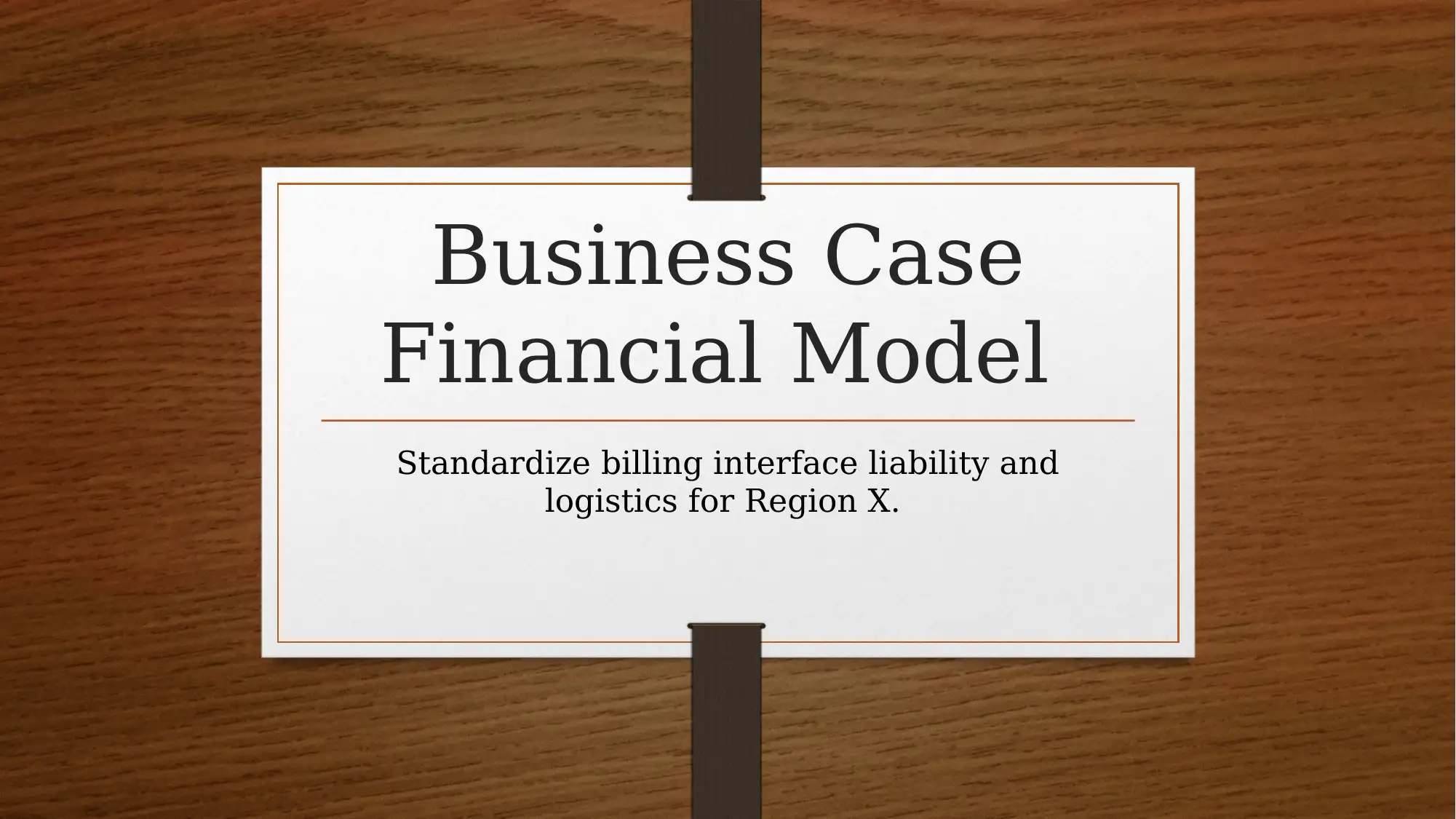
Business Case
Financial Model
Standardize billing interface liability and
logistics for Region X.
Financial Model
Standardize billing interface liability and
logistics for Region X.
Paraphrase This Document
Need a fresh take? Get an instant paraphrase of this document with our AI Paraphraser
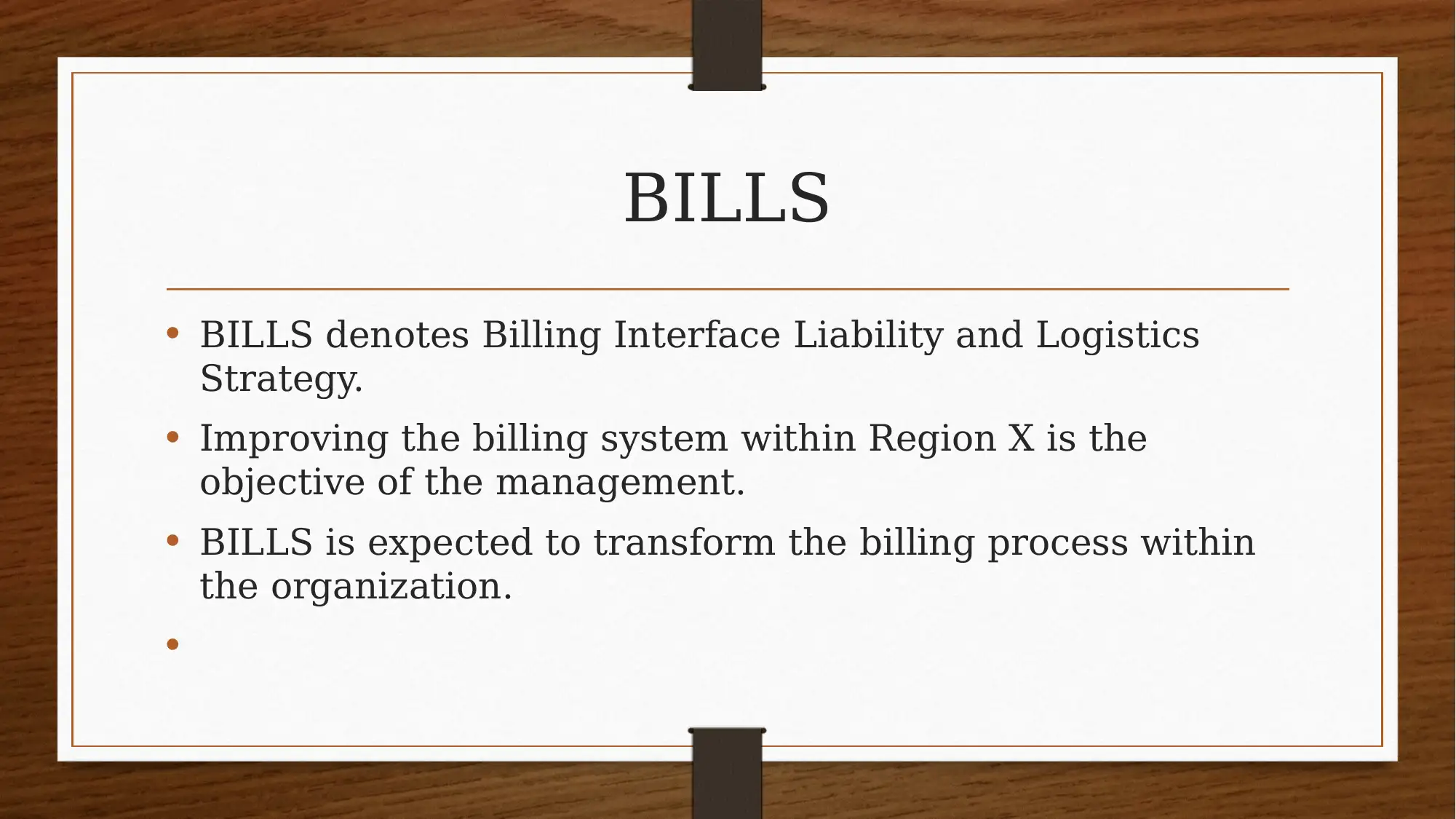
BILLS
• BILLS denotes Billing Interface Liability and Logistics
Strategy.
• Improving the billing system within Region X is the
objective of the management.
• BILLS is expected to transform the billing process within
the organization.
•
• BILLS denotes Billing Interface Liability and Logistics
Strategy.
• Improving the billing system within Region X is the
objective of the management.
• BILLS is expected to transform the billing process within
the organization.
•
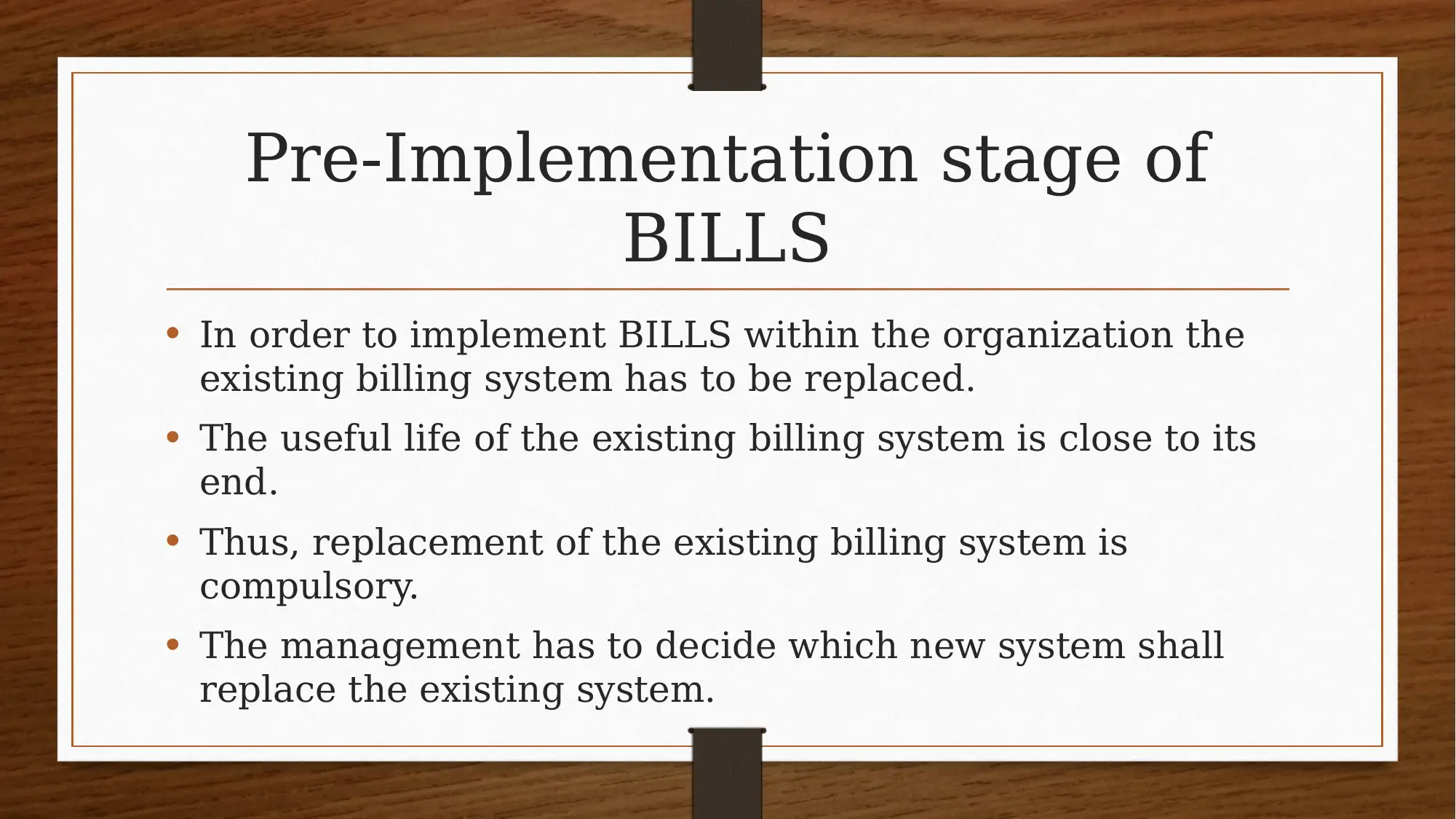
Pre-Implementation stage of
BILLS
• In order to implement BILLS within the organization the
existing billing system has to be replaced.
• The useful life of the existing billing system is close to its
end.
• Thus, replacement of the existing billing system is
compulsory.
• The management has to decide which new system shall
replace the existing system.
BILLS
• In order to implement BILLS within the organization the
existing billing system has to be replaced.
• The useful life of the existing billing system is close to its
end.
• Thus, replacement of the existing billing system is
compulsory.
• The management has to decide which new system shall
replace the existing system.
⊘ This is a preview!⊘
Do you want full access?
Subscribe today to unlock all pages.

Trusted by 1+ million students worldwide
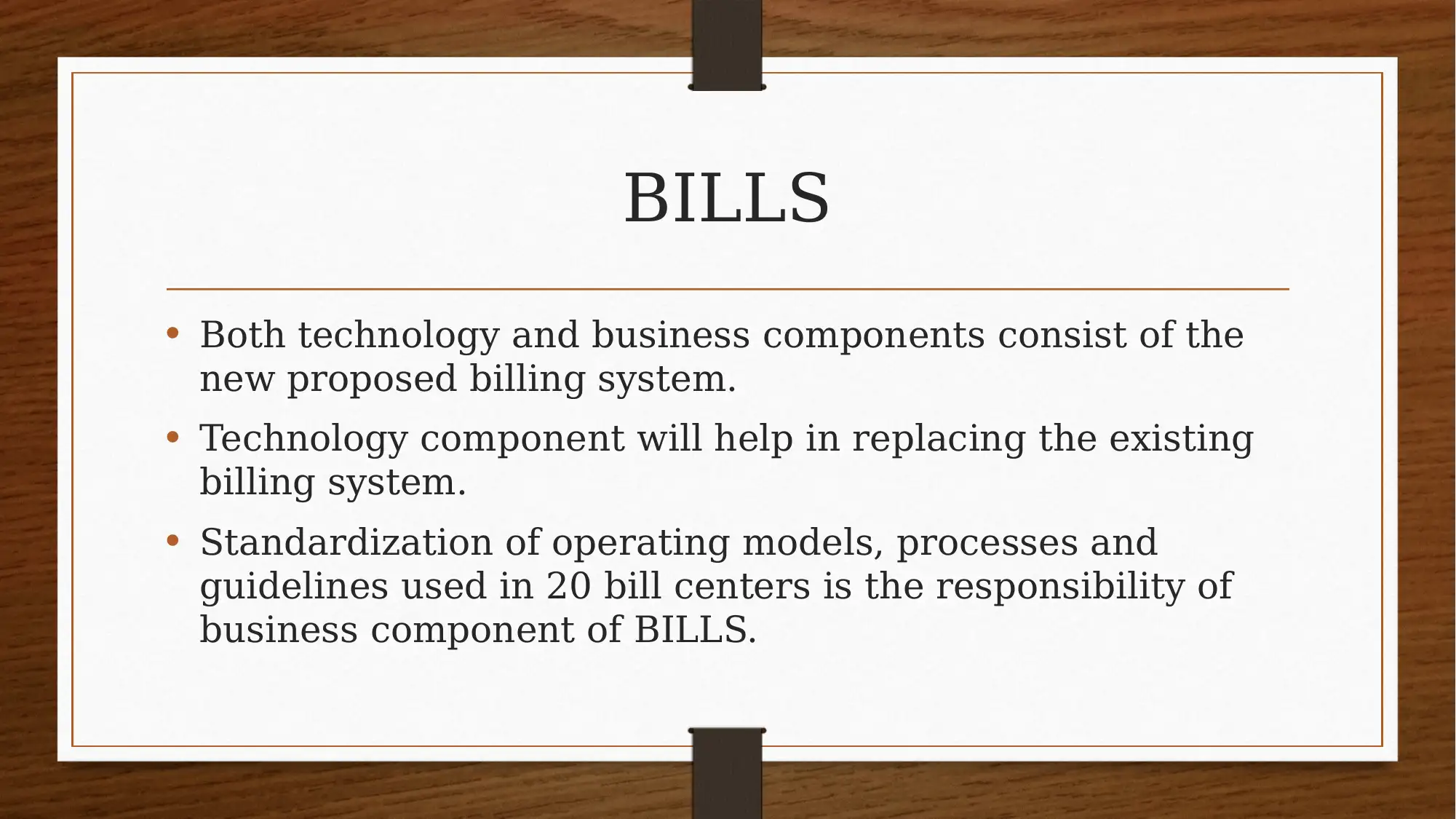
BILLS
• Both technology and business components consist of the
new proposed billing system.
• Technology component will help in replacing the existing
billing system.
• Standardization of operating models, processes and
guidelines used in 20 bill centers is the responsibility of
business component of BILLS.
• Both technology and business components consist of the
new proposed billing system.
• Technology component will help in replacing the existing
billing system.
• Standardization of operating models, processes and
guidelines used in 20 bill centers is the responsibility of
business component of BILLS.
Paraphrase This Document
Need a fresh take? Get an instant paraphrase of this document with our AI Paraphraser
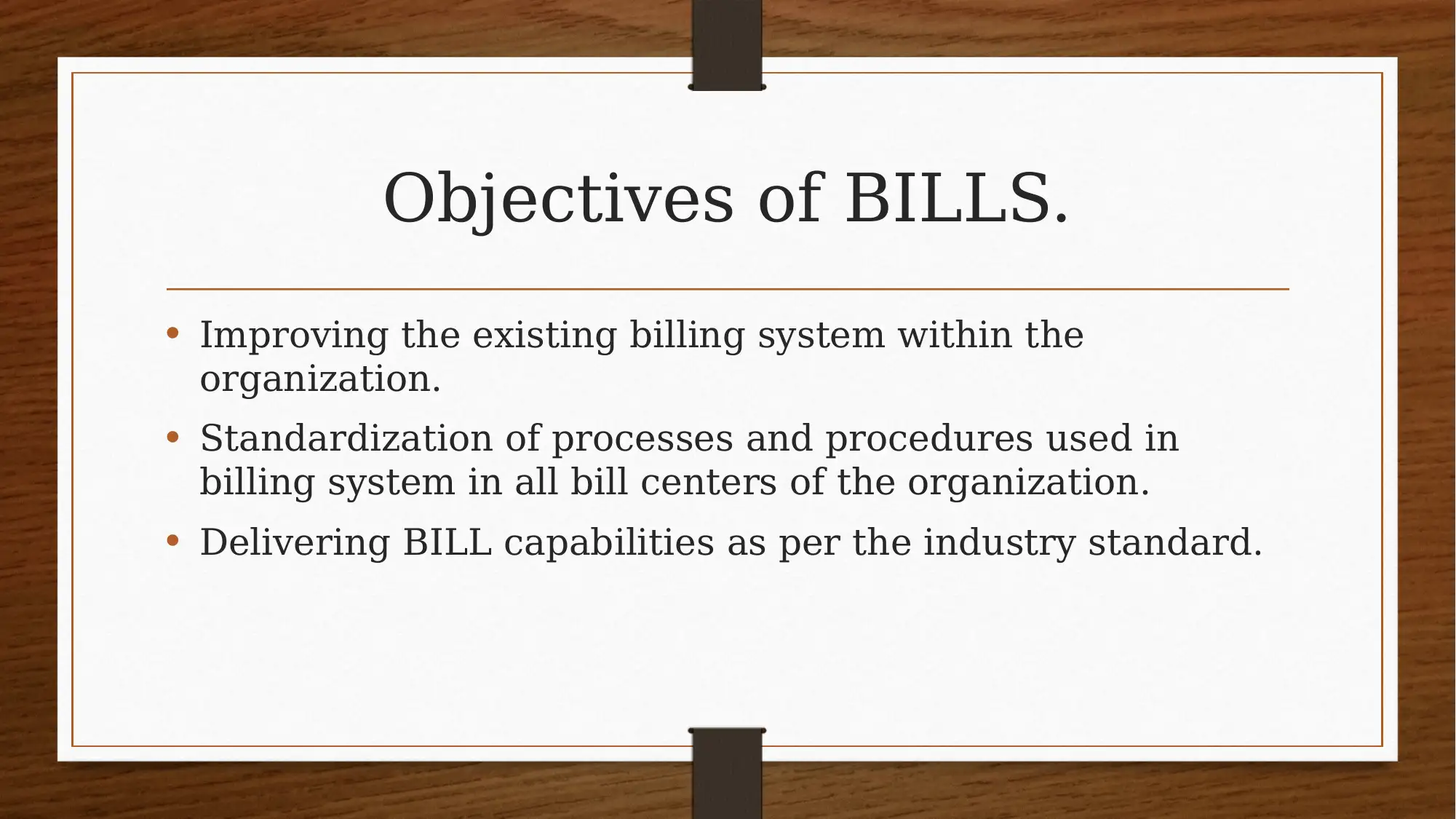
Objectives of BILLS.
• Improving the existing billing system within the
organization.
• Standardization of processes and procedures used in
billing system in all bill centers of the organization.
• Delivering BILL capabilities as per the industry standard.
• Improving the existing billing system within the
organization.
• Standardization of processes and procedures used in
billing system in all bill centers of the organization.
• Delivering BILL capabilities as per the industry standard.
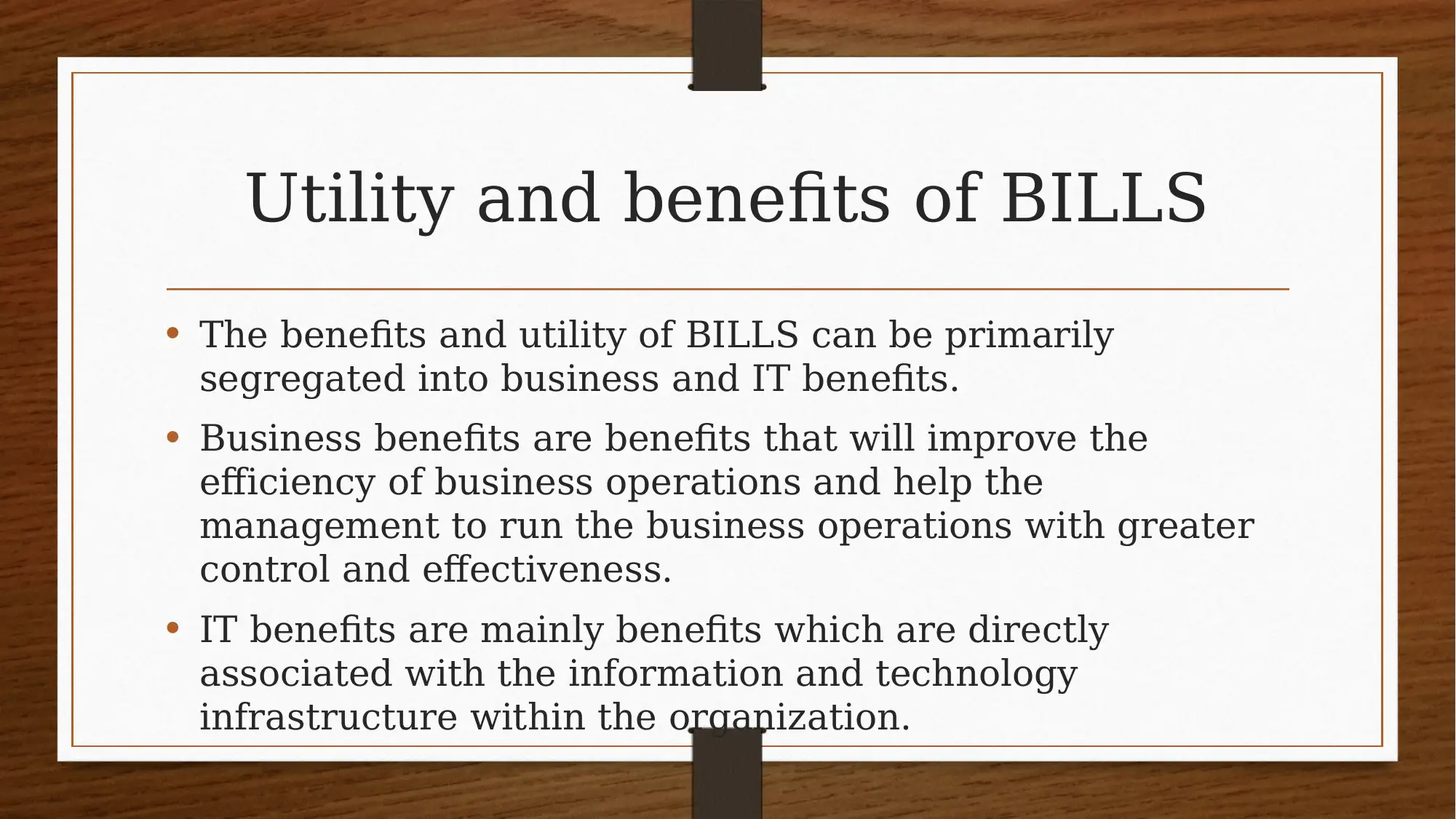
Utility and benefits of BILLS
• The benefits and utility of BILLS can be primarily
segregated into business and IT benefits.
• Business benefits are benefits that will improve the
efficiency of business operations and help the
management to run the business operations with greater
control and effectiveness.
• IT benefits are mainly benefits which are directly
associated with the information and technology
infrastructure within the organization.
• The benefits and utility of BILLS can be primarily
segregated into business and IT benefits.
• Business benefits are benefits that will improve the
efficiency of business operations and help the
management to run the business operations with greater
control and effectiveness.
• IT benefits are mainly benefits which are directly
associated with the information and technology
infrastructure within the organization.
⊘ This is a preview!⊘
Do you want full access?
Subscribe today to unlock all pages.

Trusted by 1+ million students worldwide
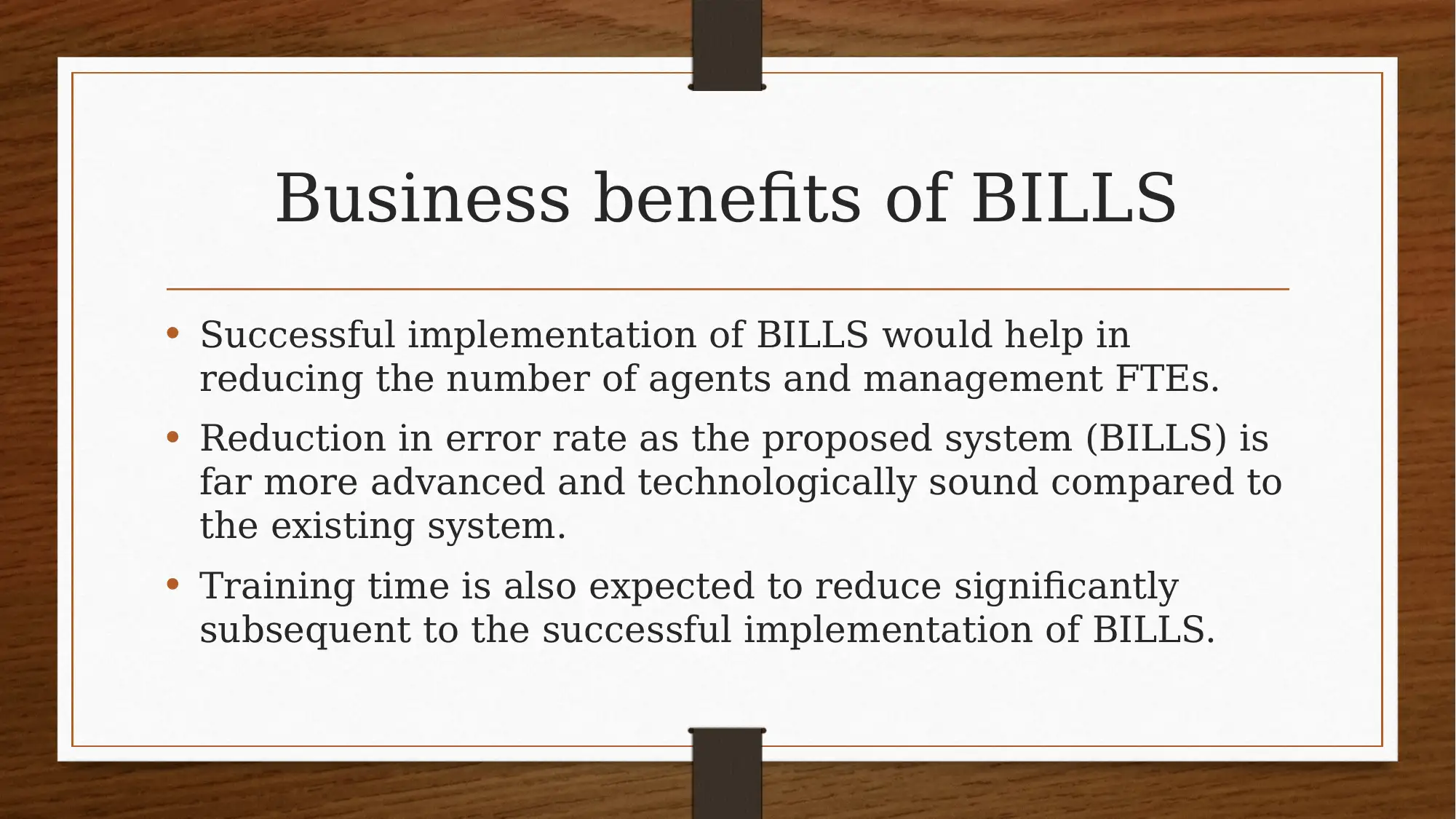
Business benefits of BILLS
• Successful implementation of BILLS would help in
reducing the number of agents and management FTEs.
• Reduction in error rate as the proposed system (BILLS) is
far more advanced and technologically sound compared to
the existing system.
• Training time is also expected to reduce significantly
subsequent to the successful implementation of BILLS.
• Successful implementation of BILLS would help in
reducing the number of agents and management FTEs.
• Reduction in error rate as the proposed system (BILLS) is
far more advanced and technologically sound compared to
the existing system.
• Training time is also expected to reduce significantly
subsequent to the successful implementation of BILLS.
Paraphrase This Document
Need a fresh take? Get an instant paraphrase of this document with our AI Paraphraser
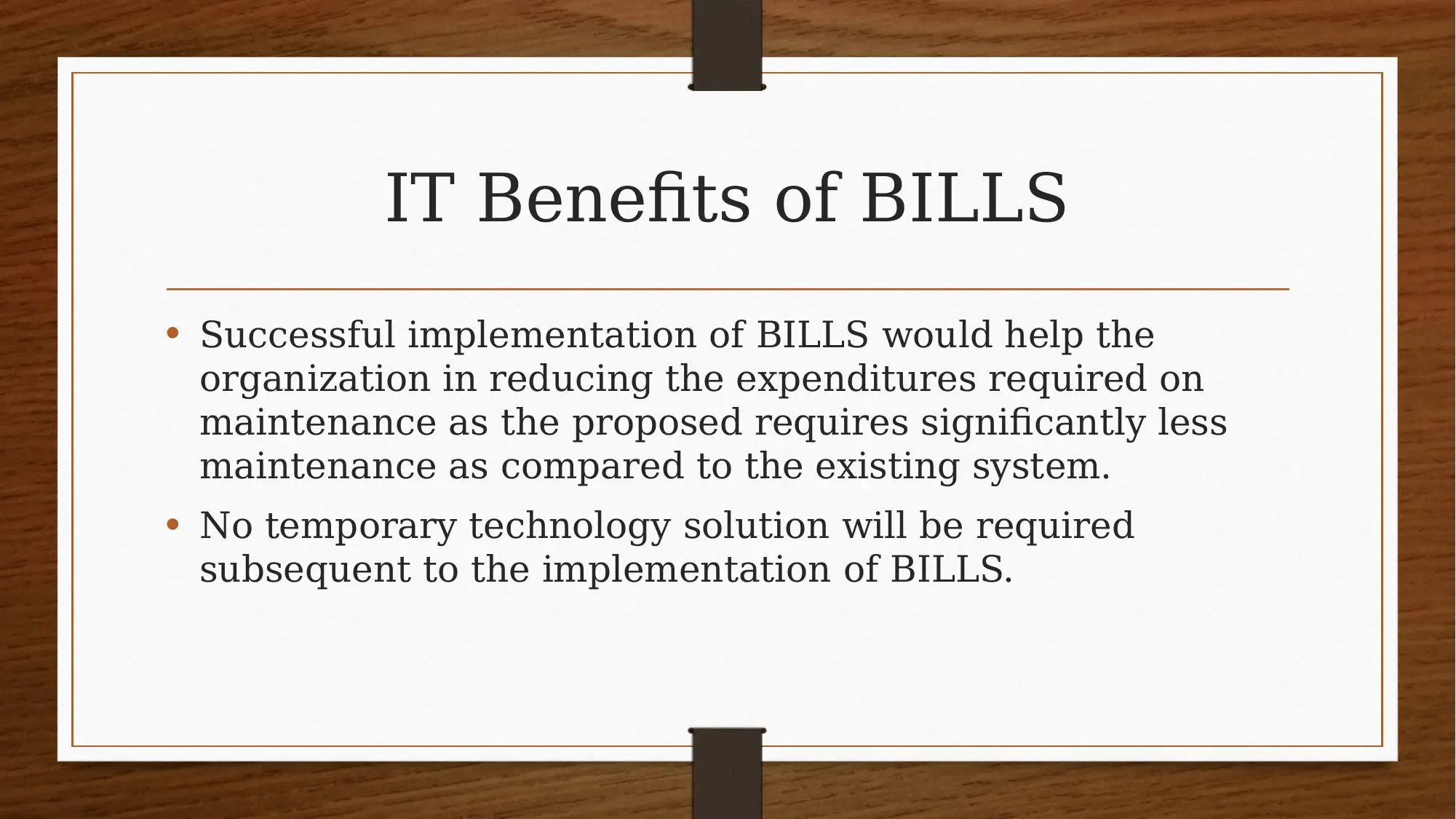
IT Benefits of BILLS
• Successful implementation of BILLS would help the
organization in reducing the expenditures required on
maintenance as the proposed requires significantly less
maintenance as compared to the existing system.
• No temporary technology solution will be required
subsequent to the implementation of BILLS.
• Successful implementation of BILLS would help the
organization in reducing the expenditures required on
maintenance as the proposed requires significantly less
maintenance as compared to the existing system.
• No temporary technology solution will be required
subsequent to the implementation of BILLS.
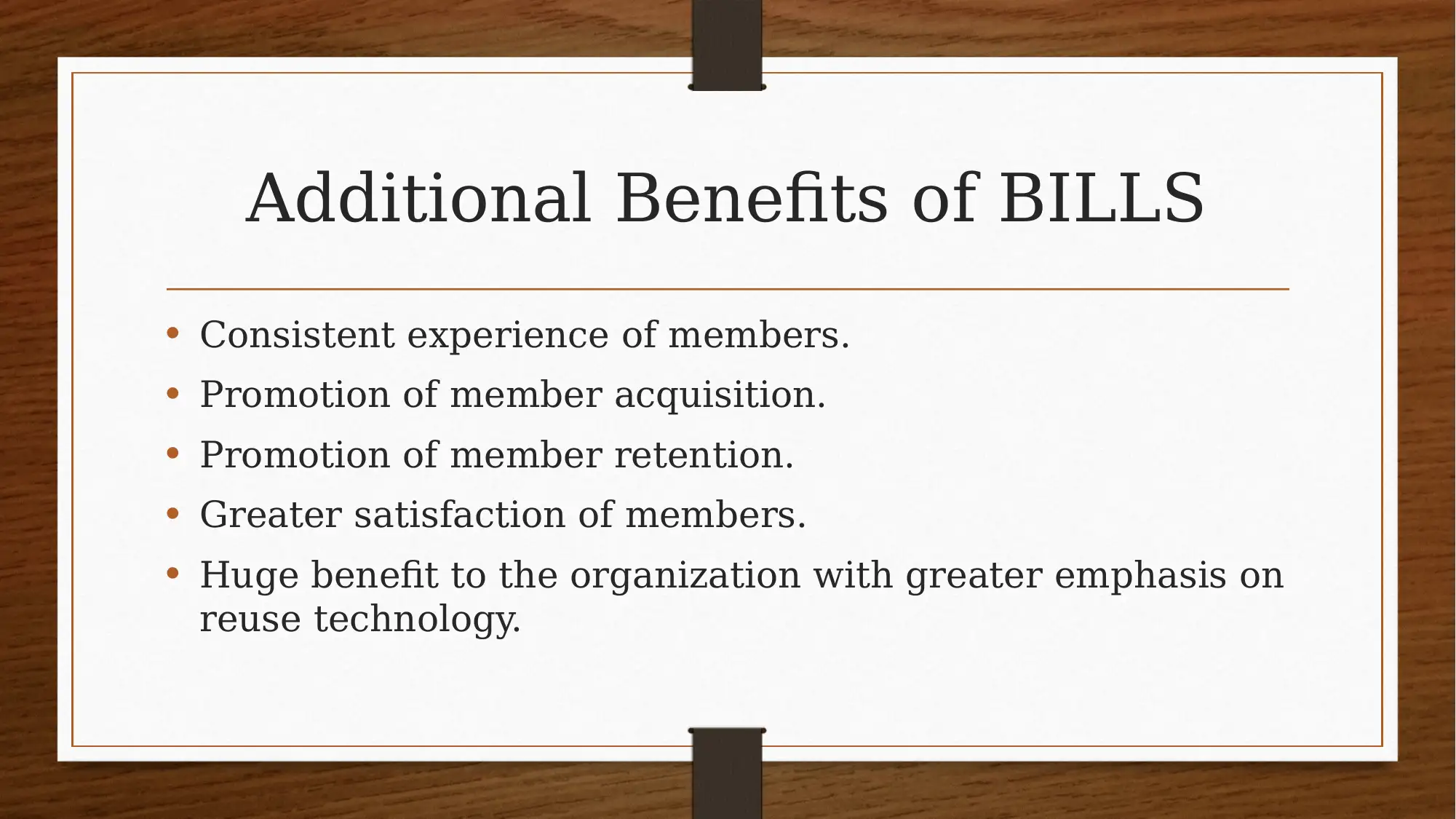
Additional Benefits of BILLS
• Consistent experience of members.
• Promotion of member acquisition.
• Promotion of member retention.
• Greater satisfaction of members.
• Huge benefit to the organization with greater emphasis on
reuse technology.
• Consistent experience of members.
• Promotion of member acquisition.
• Promotion of member retention.
• Greater satisfaction of members.
• Huge benefit to the organization with greater emphasis on
reuse technology.
⊘ This is a preview!⊘
Do you want full access?
Subscribe today to unlock all pages.

Trusted by 1+ million students worldwide
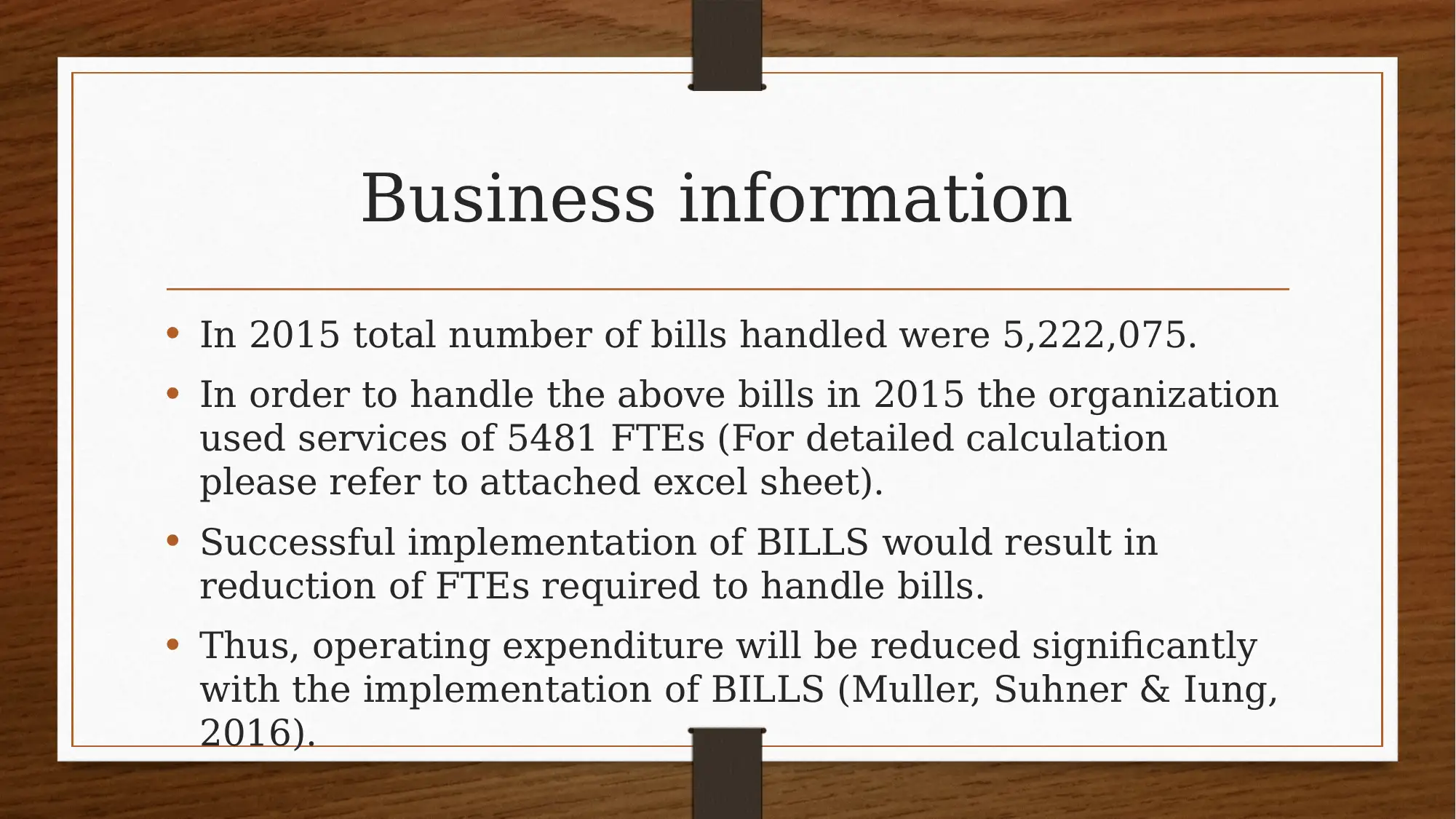
Business information
• In 2015 total number of bills handled were 5,222,075.
• In order to handle the above bills in 2015 the organization
used services of 5481 FTEs (For detailed calculation
please refer to attached excel sheet).
• Successful implementation of BILLS would result in
reduction of FTEs required to handle bills.
• Thus, operating expenditure will be reduced significantly
with the implementation of BILLS (Muller, Suhner & Iung,
2016).
• In 2015 total number of bills handled were 5,222,075.
• In order to handle the above bills in 2015 the organization
used services of 5481 FTEs (For detailed calculation
please refer to attached excel sheet).
• Successful implementation of BILLS would result in
reduction of FTEs required to handle bills.
• Thus, operating expenditure will be reduced significantly
with the implementation of BILLS (Muller, Suhner & Iung,
2016).
Paraphrase This Document
Need a fresh take? Get an instant paraphrase of this document with our AI Paraphraser
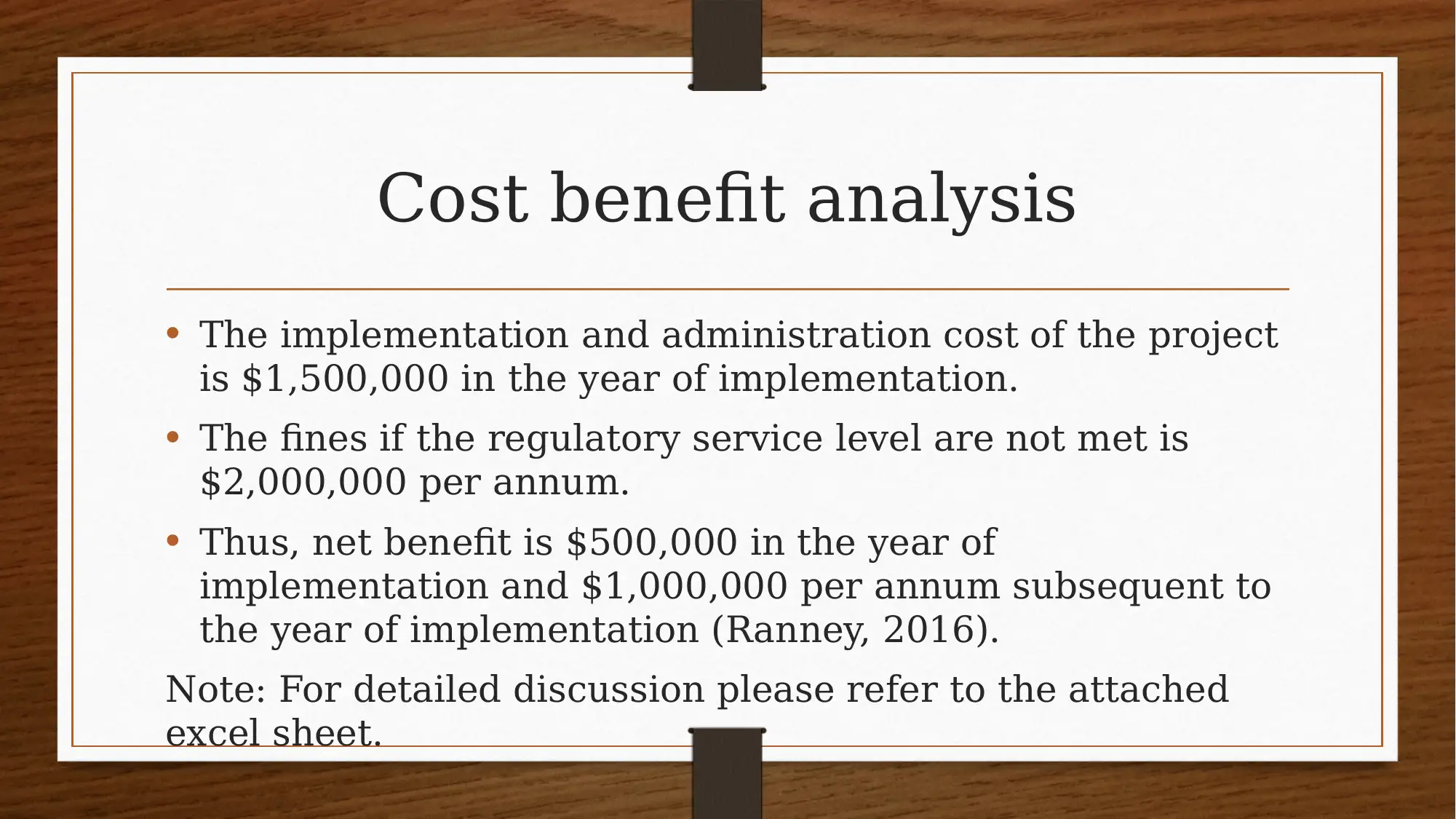
Cost benefit analysis
• The implementation and administration cost of the project
is $1,500,000 in the year of implementation.
• The fines if the regulatory service level are not met is
$2,000,000 per annum.
• Thus, net benefit is $500,000 in the year of
implementation and $1,000,000 per annum subsequent to
the year of implementation (Ranney, 2016).
Note: For detailed discussion please refer to the attached
excel sheet.
• The implementation and administration cost of the project
is $1,500,000 in the year of implementation.
• The fines if the regulatory service level are not met is
$2,000,000 per annum.
• Thus, net benefit is $500,000 in the year of
implementation and $1,000,000 per annum subsequent to
the year of implementation (Ranney, 2016).
Note: For detailed discussion please refer to the attached
excel sheet.
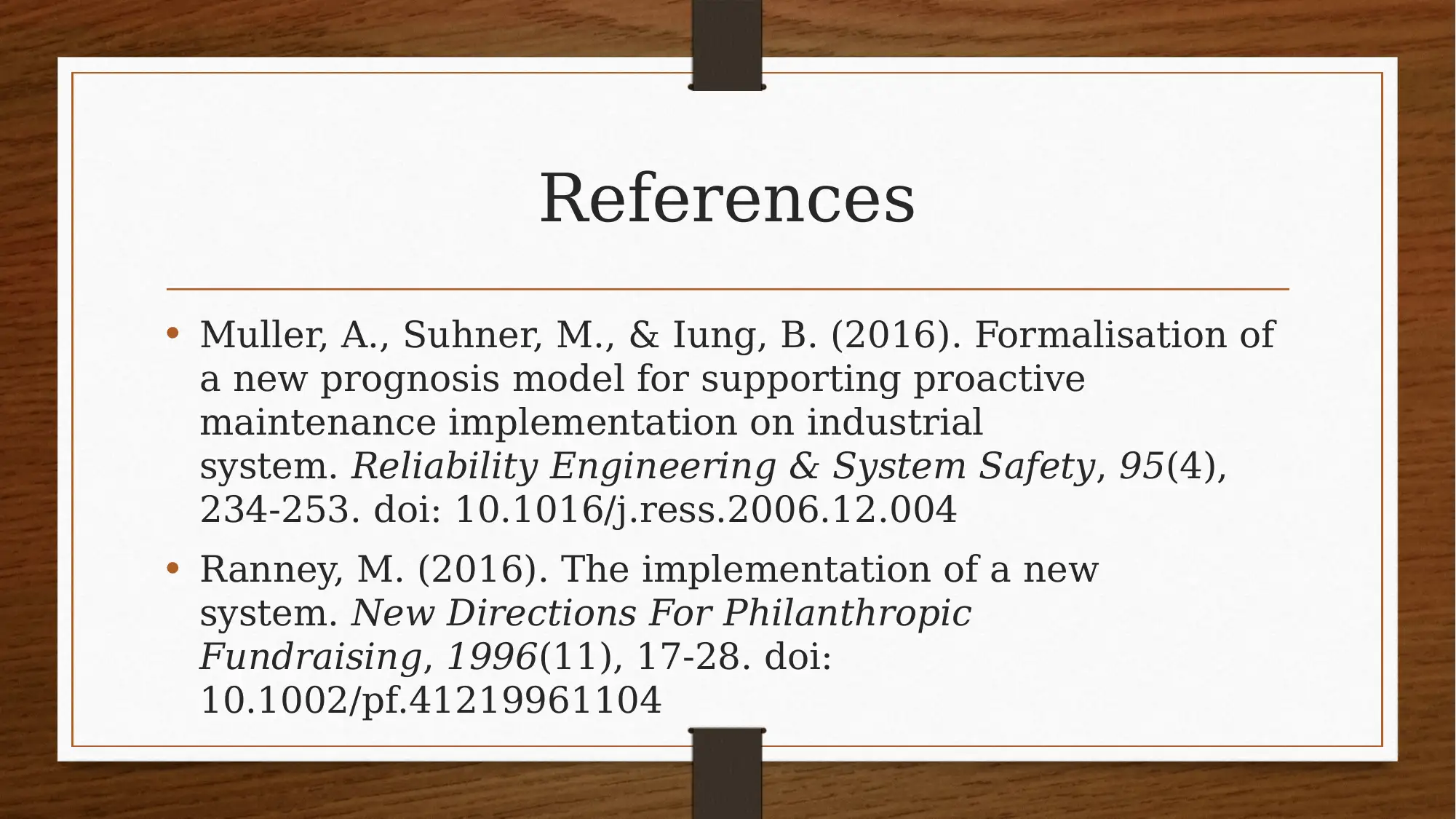
References
• Muller, A., Suhner, M., & Iung, B. (2016). Formalisation of
a new prognosis model for supporting proactive
maintenance implementation on industrial
system. Reliability Engineering & System Safety, 95(4),
234-253. doi: 10.1016/j.ress.2006.12.004
• Ranney, M. (2016). The implementation of a new
system. New Directions For Philanthropic
Fundraising, 1996(11), 17-28. doi:
10.1002/pf.41219961104
• Muller, A., Suhner, M., & Iung, B. (2016). Formalisation of
a new prognosis model for supporting proactive
maintenance implementation on industrial
system. Reliability Engineering & System Safety, 95(4),
234-253. doi: 10.1016/j.ress.2006.12.004
• Ranney, M. (2016). The implementation of a new
system. New Directions For Philanthropic
Fundraising, 1996(11), 17-28. doi:
10.1002/pf.41219961104
⊘ This is a preview!⊘
Do you want full access?
Subscribe today to unlock all pages.

Trusted by 1+ million students worldwide
1 out of 12
Related Documents
Your All-in-One AI-Powered Toolkit for Academic Success.
+13062052269
info@desklib.com
Available 24*7 on WhatsApp / Email
![[object Object]](/_next/static/media/star-bottom.7253800d.svg)
Unlock your academic potential
© 2024 | Zucol Services PVT LTD | All rights reserved.





